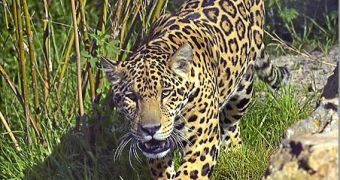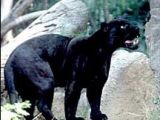1.The jaguar's closest relative is not the leopard, as you would have thought due to the spotted coat pattern, but the ...lion!
A large European jaguar (Panthera gombaszoegensis) roamed the European Mediterranean and temperate forests 1.5 Ma ago. This cat evolved into a lion and then into a jaguar.
The direct ancestor of the modern jaguar is the Ice Age North American jaguar Panthera augusta. This jaguar species lived 1,800,000 to 100,000 years ago, was about the size of a lion and reached America coming from Siberia.
2.Jaguars hunt, mainly during the night, from tapirs to pecarry, deers, capybara (the largest living rodent, up to 65 kg (143 lb), paca, agouti, armadillos, caymans, turtles, anteaters, large snakes (including anacondas), fish, frogs, sloths and small carnivores (raccoons, weasels and even other cats like ocelot, puma and ...smaller jaguars!). Jaguars clean up of meat large turtles through the fore opening; in the case of small turtles, the shell is broken with the teeth, due to the powerful jaws.
Cattle can be killed the way a lion does, by smashing their nap with a paw blow. Capybara and other preys are bitten by the skull, which is perforated in the ear area, destroying their brain, even if the capybara skull can be 2 cm (0.8 in) thick.
A jaguar can chase their prey even in the water and transport with its jaws an animal up to 300 kg (720 pounds) heavy.
3.A jaguar has a territory of 5-500 square km (depending on the prey density). Jaguars mark their territory through urine, scratches made with the claws on the trees' bark, roaring (extremely similar to the lion's), grunting, screaming and will defend fiercely its territory against another jaguar of the same sex. During the mating season, jaguars emit meows. Jaguars are good climbers and swimmers and can jump up to 5.5 m (19 ft).
4.Male detects the female through urine. Sometimes several males reach a female at the same time, but the larger has access to her and fights are rare. Only in subtropical areas (Mexico, Argentina) the breeding is seasonal.
During copulation, the male bites the female's nap to trigger her ovulation (this happens with all the cats). The females give birth to 2-4 offspring and reach maturity at the age of 3-4. Jaguars live up to 15 years.
5.Jaguars live in a variety of habitats, but avoid those extremely dry, devoid of water (like in Central Mexico) or cold climate (including the tip of the mountains). There are 8 living jaguar races: arizonensis (Pacific coast of Mexico, extinct in Arizona and New Mexico), veraecrucis (coasts of Texas, Atlantic coast of Mexico), hernandesi (southern Mexico), goldmani (Mexico), centralis (Central America to Ecuador west of Andes), peruvianus (Ecuador, Peru west of Andes), onca (from Venezuela to Guyana, southern Brazil), palustris (southern Brazil, northern Argentina, Paraguay, Bolivia). There are no jaguars in Uruguay, and in Argentina and Paraguay they are menaced. Poachers in Brazil capture jaguars with special traps, so that the animals remain alive. The animals are then immobilized using poisoned darts with curare and skinned alive, so that the skin is not damaged, having a higher value.
Black jaguars are individuals carrying a melanistic gene (that induces an overproduction of melanin, the pigment from the skin and hair).
Large male jaguars can be 158 kg (360 pounds), which means slightly bigger than a lioness.
6.How can you make the difference between a jaguar and a leopard (in zoos, of course, as you will probably not come across them elsewhere)? The rosettes on the jaguar coat have 1-4 spots in the middle. Moreover, the jaguars are stouter, with relatively thicker limbs, shorter Tails and bigger heads, more lion-like

 14 DAY TRIAL //
14 DAY TRIAL // 
